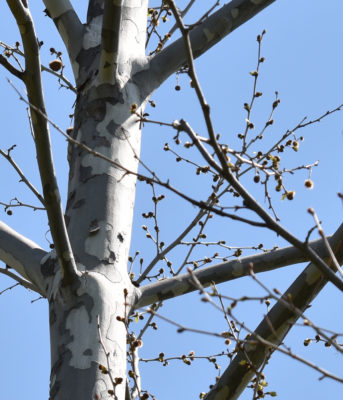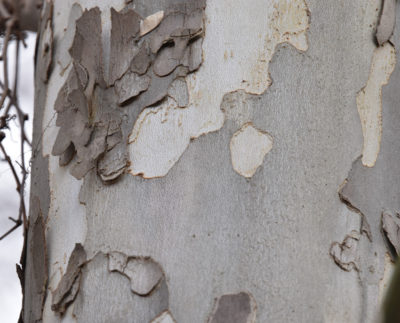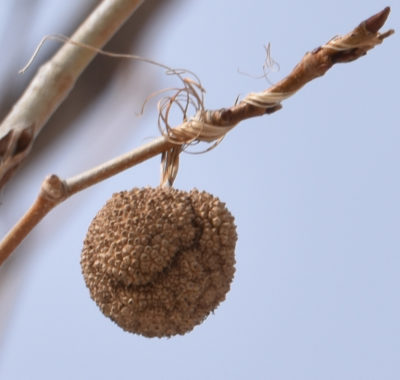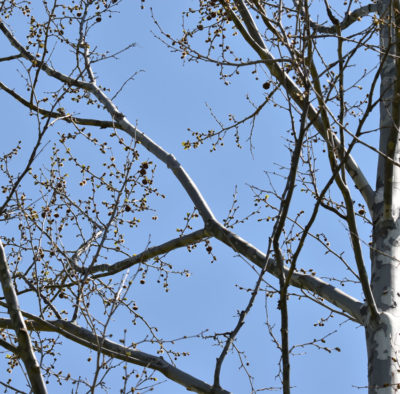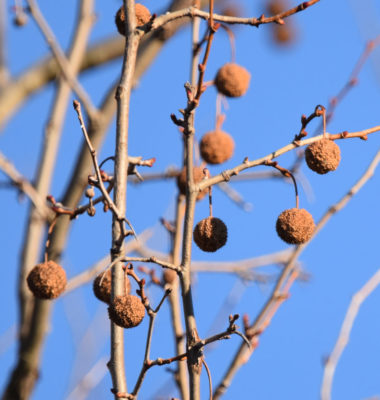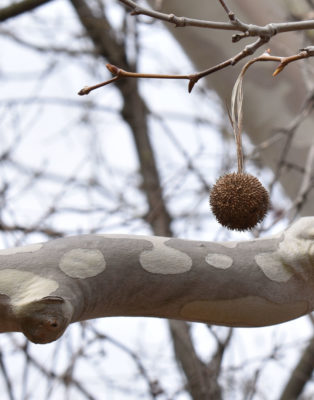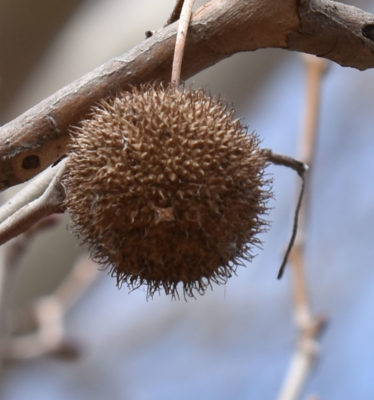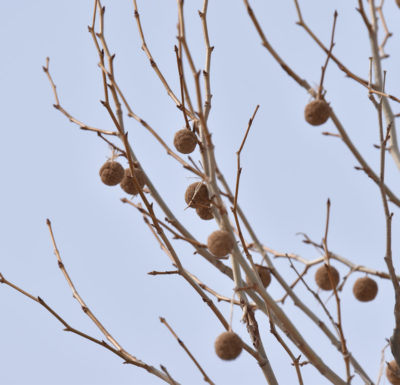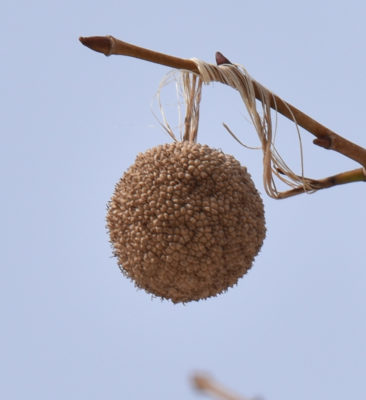I’d like to know what plants, shrubs and trees I’m looking at but I have to admit I’m not very good at identifying them. Some, however, are so obviously different from the others that even I can figure them out. For example, I recently noticed my first Sycamore tree when I was walking along the river road path at Riverwood—then suddenly I started seeing them every where I walked!
Sycamores Are Not Arbutus Trees But They Share a Trait
One thing I remember vividly about my visits to Victoria in BC is the Arbutus trees. Their bark splits apart like latex paint crackling up into shreds on top of alkyl. The vivid rusty red colour and exposed lime green new growth or grey-worn old wood make them eye catching.
So when I first saw a tree trunk covered in large loose scales of bark, I thought Arbutus. A second glance, though, showed none of those eye-catching colours. Instead, it was a series of creams, greys and light tans. Somewhere, a faint memory chimed and the word “Sycamore” surfaced.
I took some photos to remind myself to look into the guides when I got home. Sure enough, this other, unrelated tree is a Sycamore.
Spikey Spherical Fruit Hangs On Stubbornly to the Sycamore Sticks
Aside from the interesting bark, the most noticeable thing about the Sycamores I’ve found is the fruit. Or at least, it looks like fruit.
Slightly larger than golf balls, round fruit-like objects hang from the top twigs on the Sycamores well into the winter. When I looked up these tall trees, I found that the balls are actually “firm ball-like groups of many hairy seeds.” That could explain why I didn’t find any Sycamore “nuts” on the ground around the trees. Presumably when they fall, they disintegrate into the vaguely milkweed-like seeds.
Suddenly Seeing Sycamores Everywhere
I’ve seen a Sycamore at Riverwood, at Jack Darling Park beside the Rattray Marsh, at Hendrie Valley in Oakville, and at Lasalle Marina Park in Burlington. None of these locations are pristine forests though. Each of the trees could easily be a planted landscape tree.
Are Sycamores Native in Southern Ontario Or Planted?
I was pleased to find out that Sycamores are actually native to this part of Ontario. I still won’t know if the trees I’ve seen are “wild” or not but at least I know they could be.
The Three Main Plane Trees
Continuing reading made me start wondering whether the trees I have seen are really American Sycamores or non-native British or Chinese Plane Trees. There’s a good comparison of the various types in an article called the Plane Trees of London. Since the seed balls on my trees seem to be singles not pairs or more, they are probably American Sycamores.
I need to see the leaves this summer to confirm that, though. I ‘think’ the leaves looked like the American Sycamore but I may even have seen different species of trees in different locations. UPDATE: I’ve checked the trees at Riverwood and they are American Sycamores.
Why Do Sycamore and Plane Trees Lose Their Bark?
The cracking, chipping, shedding bark of these trees is really noticeable. I’ve found a few reasons why it may peel.
The Plane Trees of London site suggests that the bark lacks the flexibility to cope with the growth of the tree.
The Daily Plant website of the New York City Parks department suggests four possible reasons.
The very fast diameter growth of the Sycamore and the brittle bark combine to cause it to split and shed.
Another idea is based on the trees growing on the floodplain where water is readily available but the soils may be low in oxygen due to submersion. The exposed new bark may permit more oxygen exchange.
Some scientists have also suggested that trees that trees that shed bark are trying to keep off fungi, parasites, plants and organisms that otherwise would grow on the bark.
Finally, unlike most trees, American Sycamore can also photosynthesize through the new cells exposed when the old bark peels.
There is no one conclusive answer and of course all of these factors may contribute to the bark shedding strategy.
Does Anything Eat Sycamore Seeds?
One tree I saw at Jack Darling Park in Mississauga still had many of the round seed balls hanging from the top branches of the tree in early March. I wondered whether anything eats them.
Checking at home, I found first that the seeds of some British “Sycamores” have a toxin called hypoglycin A which can kill horses. When I checked further, I discovered they are not the same trees, though. Their “Sycamores” are a type of maple with typical maple keys (or “helicopters”) not these large seed balls. These trees are Acer pseudoplatanus.
Our trees, the American Sycamore, or Platanus occidentalis, are a type of Plane tree, not a maple.
According to the Eat the Weeds website, the seeds are eaten by Purple Finches, American Goldfinches, Chickadees and Dark-eyed Juncos. Squirrels, beavers and muskrats may also eat them. (Many Sycamores grow in wet areas like Willow trees.)
The squirrel part is confirmed by that great source of entertainment, Youtube, which has a video posted of a squirrel working its way through a seed ball.
The Plane Trees of London site says that the seed balls commonly persist through the winter and often fall apart in the spring while still hanging on the tree.
Related Reading
Join In
Do American Sycamores split their bark in a park near you? Please share your sighting with a comment.

